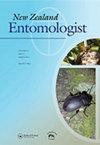Obituary
IF 0.4
4区 农林科学
Q4 ENTOMOLOGY
引用次数: 0
Abstract
John arrived at the Forest Research Institute in Rotorua in the late 1960s after a brief stint with the Marine Department and settled into the Entomology Section joining Bob Milligan, Rudy Zondag, and Bill Faulds amongst others down under the poplars at the far end of the campus. His primary focus was on quarantine border interceptions, particularly wood boring insects, which was the catalyst for him becoming an expert in the identification of cerambycid larvae and their parasitoids, particularly ichneumonidae, for which he developed a keen interest. John also made major contributions to quarantine risk management and was directly involved with the Forest Service timber inspection team, and later the MAF Quarantine Service. He was heavily involved in the risk management of Asian gypsy moth, making many pilot launch trips at various ports around the country, often in rough seas, to inspect vessels before they were allowed to berth. He also supported colleagues in a wide range of projects (even swimming the Buller River to help Gordon Hosking collect increment cores from a particularly desirable stand of red beech), but it is perhaps the white spotted tussock moth eradication project which is his lasting legacy. His untiring efforts in the field, designing and supervising population monitoring using caged female insects, a seven day a week operation, was critical to the success of the project. This was an achievement unique to the international entomological community but hardly celebrated in his own country. Following on from the successful white spotted tussock moth eradication, John was involved in the painted apple moth and Dutch elm disease eradication campaigns. The latter was not successful, but not through lack of John’s efforts. He spent over 15 years advising on the entomological aspects讣闻
20世纪60年代末,在海军部短暂工作后,约翰来到了罗托鲁瓦的森林研究所,并与鲍勃·米利根、鲁迪·宗达格和比尔·福尔兹等人一起在校园尽头的白杨树下安顿下来。他的主要关注点是检疫边境拦截,特别是钻木昆虫,这是他成为鉴定神经酰胺幼虫及其寄生蜂,特别是伊蚊科专家的催化剂,他对伊蚊科产生了浓厚的兴趣。约翰还为检疫风险管理做出了重大贡献,并直接参与了林业局木材检查小组,后来又参与了MAF检疫局。他积极参与亚洲舞毒蛾的风险管理,在全国各地的各个港口进行了多次试航,通常是在波涛汹涌的海上,在船只获准停泊前对其进行检查。他还支持了一系列项目中的同事(甚至在布勒河游泳,帮助戈登·霍斯金从一片特别理想的红山毛榉林中收集增量核心),但也许是白斑柞蚕蛾根除项目是他的持久遗产。他在野外的不懈努力,设计和监督使用笼中雌性昆虫进行的种群监测,这是一项每周七天的行动,对该项目的成功至关重要。这是国际昆虫学界独有的成就,但在他自己的国家却几乎没有得到庆祝。继成功根除白斑柞蚕蛾之后,约翰又参与了彩绘苹果蛾和荷兰榆树病的根除运动。后者并不成功,但并非由于缺乏约翰的努力。他花了超过15年的时间在昆虫学方面提供咨询
本文章由计算机程序翻译,如有差异,请以英文原文为准。
求助全文
约1分钟内获得全文
求助全文
来源期刊

New Zealand Entomologist
ENTOMOLOGY-
CiteScore
0.70
自引率
33.30%
发文量
3
审稿时长
>12 weeks
期刊介绍:
The invertebrate diversity of New Zealand is of great interest worldwide because of its geographic isolation and geological history. The New Zealand Entomologist plays an important role in disseminating information on field-based, experimental, and theoretical research.
The New Zealand Entomologist publishes original research papers, review papers and short communications. We welcome submissions in all aspects of science regarding insects and arthropods in a New Zealand or Australasian setting. The journal’s subject matter encompasses taxonomy, phylogenetics, biogeography, biological control and pest management, conservation, ecology and natural history.
The journal is the official publication of the Entomological Society of New Zealand. Papers published or submitted elsewhere for publication will not be considered, but publication of an abstract or summary elsewhere (e.g. conference proceedings) does not preclude full publication in the New Zealand Entomologist. Accepted papers become copyright of the Entomological Society of New Zealand. The journal is published in English, but we also welcome publication of abstracts in Maori.
 求助内容:
求助内容: 应助结果提醒方式:
应助结果提醒方式:


